I’m still fascinated with the goldwork-on-velvet panel I’ve been exploring lately. In discussing it with Phillipa Turnbull, who is an expert in historical embroideries, she suggested Italian, and part of a canopy from a half tester bed, confirming Lesley-Ann’s comment on the original article about the piece. The half tester is a bed with a partial canopy just above the very head of the bed. No certainty on the dates, but guessing 17th / 18th century. I may follow up with some other sources Phillipa suggested, to be more certain about the time period. I’m always for consulting experts – it’s much better than just guessing, so I was grateful that Philippa kindly took the time to discuss the piece and to recommend further avenues of exploration.
But in the meantime, what really fascinates me about the panel is the variety of goldwork couching techniques displayed in it, and the variety of gold threads and thread sizes used. It isn’t until you really get up close to the piece that you start to see all the details! I’m using a magnifier to look at some parts and take notes, but the macro setting on the camera is pretty useful, too, because it can get in there close, and then I can zoom farther in, using Photoshop.
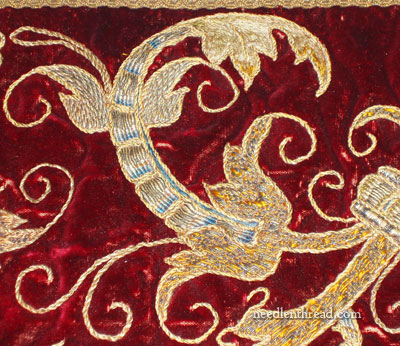
This element in the design features some interesting approaches to couching and filling.
Notice how the middle section of the element (shooting upwards in the curve) looks almost dimensional or wavy? That’s achieved by those blue stitches you see there, towards the base of each segment in that center swash.
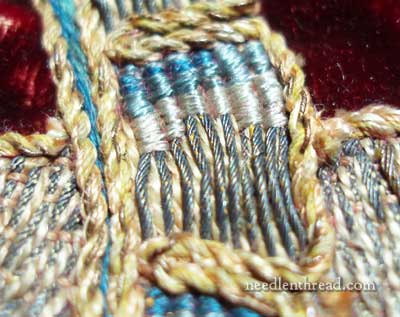
In each segment on the swash, one side of the gold and silk threads filling the segment is stitched over with colored silk, in an Or Nué-ish manner. The blue silks (three shades) are flat silk, so the sheen on the silk is quite apparent. The colored silks help couch down the gold and silk threads that run perpendicular to them, filling the small space in the segment.
Or Nué is a goldwork technique involving couching a gold thread with colored silk, and using the colored silk to create either a picture (by following the design lines of a particular object and working in details using the colored silk couched over the gold thread), or an overall effect of shading and color (by increasing and decreasing the spacing between the colored silk couching threads).
To get an idea of what I’m talking about, you can see some examples of Or Nué here on Needle ‘n Thread: this Or Nué peacock feather, and this Or Nué little flower. You can also see how Or Nué is used to created shading, looking at the robes on this Mantle of the Virgin, part of a cope embroidered in the 15th century.
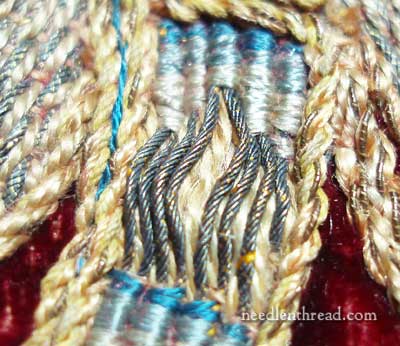
If you’re familiar with Or Nué and have seen it done today, you’ve probably seen it worked over either gold passing thread or Japanese threads, as in the examples given above. In this piece, though, the gold threads are tightly twisted gold threads, rather than the single-ply, wrapped threads like Japanese gold or gold passing. Between each gold thread there’s a bit of space filled with a thick twist of silk. So the colored silk on the ends is couching down both the twisted gold thread and the thicker silk thread. Pretty neat stuff!
That silk thread in there reminds me very much of Trebizond silk (if you were looking for a substitute today). It is thick and somewhat loosely twisted flat silk. The difference: Trebizond, made by machine, is a z-twisted thread, while the stuff in this piece is s-twisted.
I like the alternating of the silk and the gold for a filling – I may have to try this!
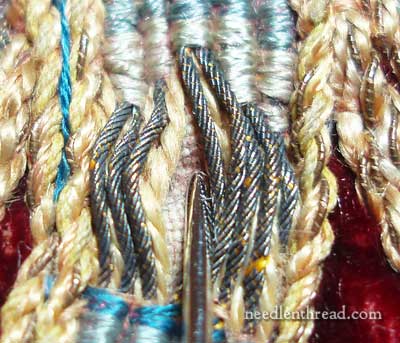
It was actually in this section that I found my opportunity to verify my guess of a linen base to all the embroidery. The threads here, because they are loose where they aren’t couched, could be gently nudged apart with the tip of a blunt tapestry needle, to reveal what was directly underneath the goldwork (a finely woven linen).
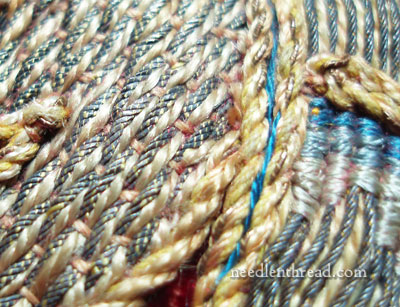
Above, you can see that right next to the segmented Or Nué element, there’s another element that is filled with alternating gold threads and silk threads. Notice that the gold thread here is also a twist, but it is a larger gold thread than the one used in the Or Nué segments (which you can see on the right in the photo above). The couching technique in the element on the left is simply an alternating “bricking” pattern, and each couching stitch holds down a gold and a silk thread at the same time.
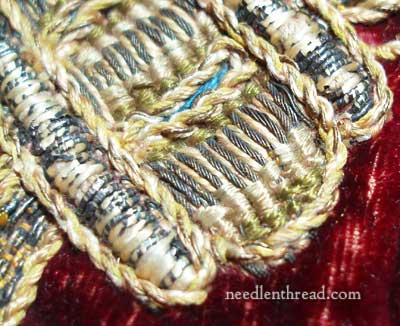
The Or Nué couching approach shows up in other places on the whole piece, so that there’s a definite unity in the embroidery. You can see the same technique here in green, over the same gold threads spaced with silk.
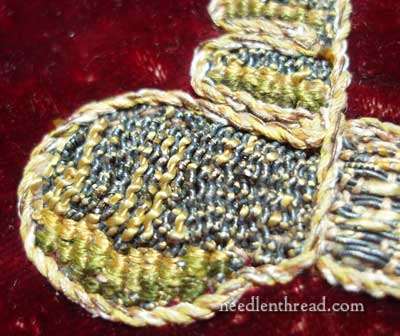
And in other parts of the design, you can see the technique worked over rococco (a wavy gold thread), without silk in between.
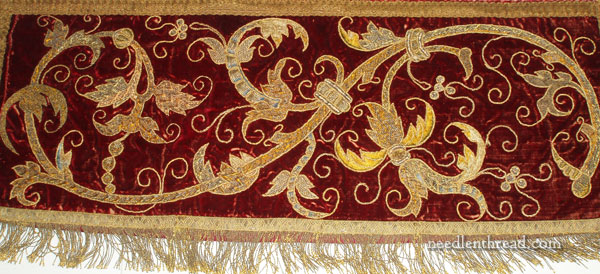
Can you tell I’m having fun with this?! I hope my explorations don’t bore you too much! There’s a lot to learn, looking closely at old pieces like this, and we don’t often have the opportunity to do so. There aren’t too many museums that would allow us to poke and prod their display pieces, after all…! I hope the techniques we’re looking at and the points we discuss along the way help to inspire you in your own needlework. Even if you never approach goldwork or silk, even if you never make your own canopy for your bed out of gold, silk, and velvet (!), my hope is that this study will inspire even more appreciation for the art of the needle, no matter what aspect of that art you pursue.
If any questions occur to you along the way, do feel free to leave a comment below, and I’ll do my best to find an answer!
And as for me, the study has convinced me of one thing – One Absolute – One Profound Truth that may influence me the rest of my life:
I need a half tester bed. With a canopy.







Mary, This is just stunning……….I’m going to pin it…..Judith Paterson
Thanks, Judith! Do pin! I appreciate it!
In response to this from your newsletter:
I need a half tester bed. With a canopy.
Yes, you do, girl!!
Heh heh. Problem is: it would never fit in my house!
Thank you so much for showing the beautiful embroidery. I was very interested to learn how it was embroidered. I love your blog and look forward to reading it each day.
I’m glad you enjoy it, Christine! Thanks for your comment!
What a wonderful opportunity to “pick” something apart. One thing that occurred to me as I was reading through your fine points — and it is something we can never know — how the embroidery developed. What I mean is, how much of the stitches and techniques you see were actually the original intent of the embroiderer and how much was made up as he/she went along. You know how you stitch something up, but it doesn’t quite work as you intended — so you start filling in and stitching levels upon levels doing “whatever it takes”. I remember an assignment in high school where we were supposed to write a 20-page essay analyzing some classic painting. At the end of the 20 pages, I was sure that the artist hadn’t given nearly this much thought to what he had done — he had just “done it”!! haha Just saying……. But this piece IS fascinating! Thank you.
Good point, Bobbi! Your example reminds me of my students, when studying poetry. “How do we know the author really meant it to be interpreted that way!?”
While looking at some of the older posts as referenced in this article, I came across this and ask for your permission to print, with attribution, in our EGA chapter newsletter:
Oh give me time, lots of time, with my Ott light up above.
Please fence me in!
Let me spend every minute on the stitching that I love.
Please fence me in!
Let me be by myself in the evenings, please!
In linen, and gold and silk threads up to my knees!
Send me off forever so I can stitch at ease…
Please fence me in!
I showed this to my husband and he said “Sign me up for tonight!” and immediately purchased a ticket for the local baseball team tonight!
Hi, Susan – that’s fine! Please reference Mary Corbet’s Needle ‘n Thread http://www.needlenthread.com
Thanks for asking!
Enjoy the game! 🙂
Beautiful!
I’m currently picking apart (on my computer, with hi-res photos) a 16th c. Spanish ecclesiastical garment from a local museum with similar swooping vines, and equally fascinating mixture of goldwork techniques. It, too, is on red velvet (but not in such great condition as your example). I’m currently trying to figure out whose it was, based on a multi-quartered coat of arms, and from that, determine if the 16th c. attribution by the museum is reasonable. So I was wondering – what evidence points you towards a 17th – 18th century provenance?
I’m not sure about the dates. Incidentally, Philippa found another piece very similar to this, that’s 16h century. I’ll write about it later on, hopefully. In the other piece the description is 16th century on the embroidery, but moved to a velvet ground in the 18th century.
Mary, I’m finding your study of this goldwork piece and the techniques involved fascinating not boring. I don’t often get the opportunity to go out and look at embroideries so studying like this is good for me. Thank you for such a great read. Kind Regards Mandy Currie
Thanks, Mandy! I love exploring these kinds of things… But I’m always afraid I might be overdoing it, so it’s nice to hear others enjoy it, too!
I keep reading on this particular topic as you progress and I’m more and more speechless at how much work went into making this. I can barely find the time to work on my redwork alphabet that I want to turn into a quilt. This level of work and expertise blows me away. And then you say it’s probably a canopy over a bed? Who would go to so much trouble to hang this over a bed? Goodness!
Hi, Irene –
Most likely this was done by professionals. As for the bed canopy… Well, the people who enjoyed such decor obviously had someone else keeping it clean! 🙂
Here’s one reader who is definitely NOT bored. I’m enrolled in the Cabinet of Curiosities online course, and I took the liberty of telling my 300 or so classmates about this post…there’s a whole thread full of folks in the class who won’t be bored with this either! I just wish I could actually see this thing in person too. Thank you so much for sharing it with us, and I hope you give us even more of the ‘inside story’!!!
Hi, Elisabeth – thank you! I hope you’re enjoying the class – it is surely a fascinating adventure!
What a fabulous opportunity you are offering us, to see this up close and very personal. I love the long view, seeing it as it would have been in its glory days. The design is gorgeous.
And I must say, I am with you. I want a half-tester with a velvet embroidered panel like this. When do you think you will be able to fit them into your schedule? Ha-ha.
Mary, I would like your opinion on ‘pinning’ please? I have never done it, nor even looked at the site, but I know that other artists are not keen because of the copyright implications.
Hi, Christina –
I have no problem with people pinning my stuff on Pinterest, as long as attribution is made, or it is pinned with the link (which happens automatically when you pin using the URL). In fact, I like Pinterest, and I think if people use it correctly, it can be a great tool!
Super article Mary…loved it, and I got the biggest kick out of your last 2 sentences…cracked me up! 🙂
Well, now I just need to build the house to accommodate the half tester… But I don’t think that will ever happen! 🙂 Thanks, Angela!
Mary, you have one already!
Although it is not just a mere tester bed, it is a full sixteenth century four-poster. It’s called the Corbet Bed and it’s on display here in the museum in Shrewsbury, with a fine set of hangings made a few years ago by a large team of embroiderers in Shropshire. (Sad to say, I was not involved in the bed project.)
http://www.darwincountry.org/explore/001713.html
Sue! Thank you so much for that link! I LOVE IT! I must explore it further! What a project!
Hi Mary,
This project is wonderful.I wanted to tell you I am a huge fan of your artwork.I am always getting new ideas from your ‘How to videos’ section.I have recently made my first embroidery project by your really helpful videos. I want you to see my work
at http://luvforcrafts.blogspot.in/ and please give your feedback
Regards
Moushumi
Thanks, Moushumi – your project is very nice! Congratulations on a job well done! – MC
Dear Mary
Thanks for this article so interesting the goldwork and silk are gorgeous the detailed work that went into this piece is amazing.
Mary I love your site every time I have a question about embroidery I just type it in the search site on needlenthread and there is always a blog that you have written about, so thank you.
Regards Anita Simmance
Thank you, Anita!!
I’m really loving your examination of this piece, Mary. It’s like eating chocolates!!